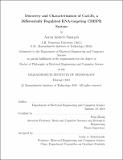| dc.contributor.advisor | Feng Zhang. | en_US |
| dc.contributor.author | Smargon, Aaron Andrew | en_US |
| dc.contributor.other | Massachusetts Institute of Technology. Department of Electrical Engineering and Computer Science. | en_US |
| dc.date.accessioned | 2018-05-23T15:05:49Z | |
| dc.date.available | 2018-05-23T15:05:49Z | |
| dc.date.copyright | 2018 | en_US |
| dc.date.issued | 2018 | en_US |
| dc.identifier.uri | http://hdl.handle.net/1721.1/115637 | |
| dc.description | Thesis: Ph. D., Massachusetts Institute of Technology, Department of Electrical Engineering and Computer Science, 2018. | en_US |
| dc.description | This electronic version was submitted by the student author. The certified thesis is available in the Institute Archives and Special Collections. | en_US |
| dc.description | Cataloged from student-submitted PDF version of thesis. | en_US |
| dc.description | Includes bibliographical references (pages 129-144). | en_US |
| dc.description.abstract | RNA plays a significant role in human biology and disease, not only as messenger RNA encoding proteins but also as noncoding RNA regulating DNA, proteins, and other RNA species. Until recently, it has been challenging to target RNA in a simple, efficient manner. CRISPR-Cas (clustered regularly interspaced short palindromic repeats and CRISPR-associated proteins) systems, which confer adaptive immunity to prokaryotes, have revolutionized DNA targeting through the engineering of RNA-programmable Cas9-based tools. Effective RNA-programmable RNA-targeting tools would likewise transform RNA biology and biotechnology. Class 2 CRISPR-Cas systems, which rely only on a single effector protein and programmable CRISPR RNA (crRNA) to target nucleic acids, represent the most promising tool to target RNA. Building on previous research, a biocomputational pipeline was developed to discover novel functional class 2 CRISPR systems lacking the canonical adaptive machinery of Cas1 and Cas2 at their genomic loci. Out of this pipeline emerged the class 2 CRISPR-Cas RNA-targeting system, VI-B (Cas13b with accessory Csx27/Csx28). Cas13b was characterized both biochemically and genetically, and found to be differentially regulated--inhibited by Csx27 in VI-B1 systems and enhanced by Csx28 in VI-B2 systems. RNA-targeting rules are critical to tool development, and so an E. coli essential gene screen was conducted and analyzed to assess the RNA sequence and structure requirements for targeting. The completion of this work advances both knowledge in the CRISPR field and possibilities in the RNA-targeting toolkit. | en_US |
| dc.description.statementofresponsibility | by Aaron Andrew Smargon. | en_US |
| dc.format.extent | 144 pages | en_US |
| dc.language.iso | eng | en_US |
| dc.publisher | Massachusetts Institute of Technology | en_US |
| dc.rights | MIT theses are protected by copyright. They may be viewed, downloaded, or printed from this source but further reproduction or distribution in any format is prohibited without written permission. | en_US |
| dc.rights.uri | http://dspace.mit.edu/handle/1721.1/7582 | en_US |
| dc.subject | Electrical Engineering and Computer Science. | en_US |
| dc.title | Discovery and characterization of Cas13b, a differentially regulated RNA-targeting CRISPR system | en_US |
| dc.type | Thesis | en_US |
| dc.description.degree | Ph. D. | en_US |
| dc.contributor.department | Massachusetts Institute of Technology. Department of Electrical Engineering and Computer Science | |
| dc.identifier.oclc | 1036987560 | en_US |
